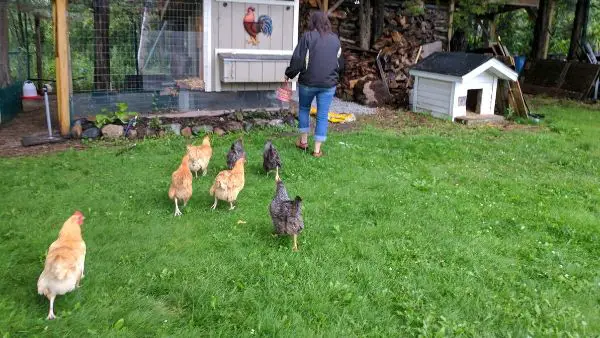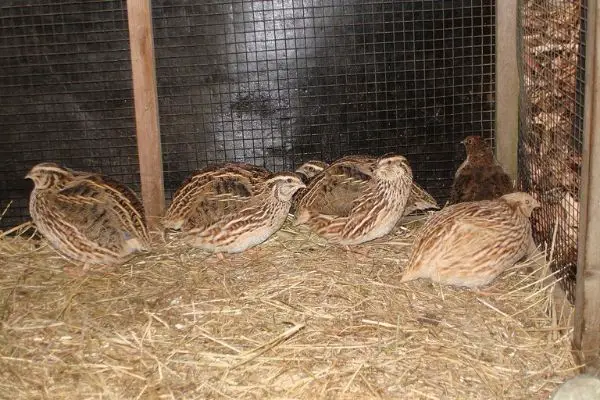The U.S. Department of Agriculture states that the number of people raising backyard poultry has increased by nearly 40% since 2013. Most homesteads tend to start with chickens, and then add quail to their coop later on. Quail are easy to raise, especially if you have a foundation in poultry through raising chickens; however, many precautions must be taken to keep both your quail and chickens thriving.
How do you raise chickens and quail together? Chickens and quail must be raised in separate pens, but can be raise concurrently. There are many differences between the two birds that prevent them from being able to be raised together. Some of the characteristics of chickens and quail that you need to consider are:
- Food specificities of each bird
- Amount of room needed per bird
- Size of the bird
- Each bird’s ability to fly
- The personality of each bird
- Maturity rate of the birds
- Egg production of each bird
- Meat production of each bird
Quail are not as common as chickens; however, they outweigh chicken’s efficiency in nearly every capacity. It can be effortless to integrate quail into your homestead if you’ve already been raising poultry. Use this guide to understand distinctions between each species, how to raise them safely, and the benefits you can reap as a responsible homestead owner.
The Differences Between Chickens & Quail
These two birds each make wonderful backyard livestock or pets for a multitude of reasons, but each has its own specific needs.
The central distinctions to be aware of are as follows:
| Poultry Species | Chickens | Quail |
| Food Specificities | Requires more food than quail per egg. Require chicken-specific feed *cannot eat quail food. | Requires notably less food than chickens per egg. Require quail-specific feed *cannot eat chicken food. |
| Amount of Room Needed Per Bird | About 2 to 3 square feet per bird of indoor coop space. About 8 to 10 square feet per bird for an outdoor runs | About 1 square foot per bird of indoor space. About 3 to 5 square feet per bird for outdoor runs |
| Size | The average adult chicken (dependent on breed) weighs about 6.32-pounds. | The average adult is 3.4-ounces, dependent on quail breed. (Brown Coturnix Quail can weigh up to 14-ounces). |
| Ability to Fly | Somewhat, flies mostly horizontally and not very high. Our chickens can only get about 4 feet off the ground. | Yes, you need netting on top because your quail will attempt to fly away. |
| Personality | More aggressive and will bully quail if kept together. | More gentle in temperament, can be killed by chickens if kept together. |
| Maturity Rate | Slow – Don’t usually produce eggs until about 6 months old. | Very Fast – Within the first 6-8 weeks of their life they are ready to produce eggs. Quail will have laid about 100 eggs by the time the chicken is mature enough to produce eggs. |
| Egg Production | Usually lay about five eggs per week. Typically lay up to 200-250 eggs in their first year depending on the breed. | Can lay seven eggs per week. Typically lay up to 300 eggs in their first year. |
| Meat Production | Must be harvested early in life as a young chicken to have tender ‘fryable’ meat. Produce more meat but must be fed considerably more than quail. | Can be harvested at any age for high-quality meat. They have a more gamey, slightly richer taste. Much less meat per bird, but nearly 4x the amount of Vitamin C as compared to chicken meat. |
Some of these factors will vary depending on the various breeds within each species, so research your unique breeds to be sure of their specific traits.
Basic Overview – How to Raise Chickens and Quail Together
For many years, people said that these two species should never be raised together. It was not until about ten years ago that people realized they could be raised together on the same homestead safely, but only with deliberate planning and forethought.
It is quite possible to run a successful cross-homestead with multiple species of poultry, (whether you’ve done it before with chickens or you are entirely new to it). But it must be done so with intention and plenty of research beforehand.
Remember: Quail can be raised nicely alongside chickens, but never in a joint coop.
This estrangement is necessary, due to chickens’:
- Larger size
- Aggressive temperament
- Need for more space
You must keep your quail separate from your chickens because their survival depends on it.
Why You Should Consider Free-Range Poultry
All animals will thrive from having space to roam. Chickens and quail will will definitely benefit from having outdoor-coop or free-range options. If you can offer them this, you will experience:
- Healthier animals
- Happier animals
- More egg production
- Healthier meat with lower levels of:
- Cortisol
- Adrenaline
- Other steroids and negative-hormones

A happier bird with more space to be free-range will offer yields of meat that is:
- Lower in glycogen
- Lower in lactic acid (which can be released when they are slaughtered in fear)
- Higher quality meat and eggs
The more square footage that you can offer them, the better. Without sufficient room to live, your birds will start displaying the following behaviors:
- Stress
- Pecking each other
- Cannibalism and death
If these warning signs occur, you are not offering your birds enough space to live comfortably.
Reasons Why You Need to Keep Them Separate
This must be your priority as a poultry farmer of both chickens and quail. The reasons to keep your coops separate for chickens and quail are as follows:
Reason #1 Disease Control
Diseases are no strangers to birds. With many diseases being quickly passed between birds, they may be a carrier of the disease even if they do not display symptoms of illness. It is difficult to control this among dozens of birds, and the consequences are amplified when you are incorporating new species into that mix.
The diseases will most commonly be passed from your chicken to your quail, not the other way around. The most common condition which can be spread is Coryza.
Coryza
Coryza is an infectious disease that is most commonly passed between chickens and quail. This targets the respiratory system of birds and will cause the following symptoms:
- Swollen eyes and face
- Discharge from the nasal cavities
- Sneezing
- Lethargic or sluggish behavior
- No appetite
- Not drinking water
- Not producing eggs as fast or at all
Michigan State University says that older birds and birds that have suffered a recent stress event are more likely to be at risk.
Other Diseases
There are also some less common diseases that can inflict poultry, but are still a threat to their health. Here’s a list of what to be mindful of:
- Coccidiosis
- Aspergillosis
- Omphalitis
- Ulcerative Enteritis
Many of these can be cured with antibiotics, but only if caught early. If not, this can spread through your coop and wipe out an entire flock. Much more in-depth information about these diseases can be found at the Happy Chicken Coop.com
Chickens will respond best to medicine; however, quail will likely perish if illness begins to spread.
Salmonella
Keeping a clean poultry coop free from disease, will help to not only keep your birds healthy, but also keep you and your family healthy too.
Kate Gibson, from CBS News, says in her article, ‘The Biggest Source of Salmonella Outbreaks In The U.S. May Be In Your Backyard:’
“The backyard trend is linked to 768 salmonella-related illnesses so far this year [2019] — including two deaths — but the actual tally is far higher, according to the U.S. Centers for Disease Control and Prevention.”
Reason #2 Chickens Are Aggressive Towards Quail
Beyond disease control, the temperament of each bird is another reason to keep quail safe from your chickens. Chickens will create a literal “pecking-order” among themselves and any quail in the mix would be way down on the bottom of that order.
Chickens, when forced together with quail, are known to:
- Become aggressive
- Not let quail have access to any of the feed
- Peck at them
- Injure them
- Potentially kill them
- Potentially will eat them – Keep in mind that chickens are omnivores and won’t hesitate to make a protein-dish out of your quail.
Even if this does not occur, you are risking the spread of disease, and these two creatures are not meant to co-mingle in a singular habitat. Quail will determine their pecking-order within their own coop, but you cannot force this social process to occur in tandem with chickens, or else your quail will not fare well.
Reason #3 Chickens Will Eat the Quail Eggs and the Quail
Covered briefly above, chickens are omnivores that will eat nearly anything you place before them. Their curious nature will cause them to start pecking anything.

Once they taste a quail’s egg, they fall in love and can’t control themselves. Horrific as that may seem, if they discover a quail’s egg, they will start to eat into your profits by not only cracking the quail eggs open but also potentially eating the actual quail birds.
Even if you didn’t mind them eating quail eggs, keep in mind that by allowing them to eat quail eggs, they learn a new habit. Poultry experts describe that quickly after discovering the quail’s eggs, chickens tend to consume their own eggs.
This new taste will cause them to pursue and consume their own chicken eggs, whereas that desire would not have been triggered without crossing these two incompatible species.
Reason #4 Quail Can Fly, Chickens Cannot
Because of this, you will need a completely different coop-construction than your standard chicken coop. If you want to offer free-range, this can complicate things because you don’t want your quail to start flying in every direction.
A high-fence can keep a chicken in easily (because they can only really fly side to side for short distances). This won’t suffice for a quail because they fly vertically (straight up) and will need rooftop security to keep them enclosed.
Reason #5 They Eat Differently
You don’t want either species to have access to each other’s feed.
This can cause a multitude of issues, such as:
- Too much protein for your chickens
- Not enough protein for your quail
- Quail may not get any food (because chickens will dominate the coop and prevent them from having access; quail will become malnourished & starve to death).
- Digestive issues
- Potentially death
Please respect all of these differences and do not cohabitate these two species. You can happily raise the two of them side-by-side, by not together.
How to Build Your Separate Coops
Building a coop is pretty straightforward for the average homesteader. Here’s a great resource from easycoops.com for ready made chicken coop plans or if you want to design it yourself here are tips about constructing each coop:
For Chickens:
- Offer 2 to 3 square feet per bird
- Keep a chicken wire fence
- Build a ramp leading into their coop
- Place plenty of hay or cushion on the ground
- Chickens are social, and you will want at least 6 of them so that they don’t feel lonely. This requires a coop that is at least 18-square feet wide. Their run should be the same size or larger (run being the free-outdoor space that they can run within the chicken house or coop).
- Keep a ratio of 1 nesting box for every 3 to 4 birds.

Cumberland Cottage Chicken Coop, DUS200120 [More]
There are plenty of pre-built chicken coops such as the one above from Tractor Supply Company, but you must size this to the number of birds in you plan to keep.

For Quail:
- Offer at least 1 square foot per bird
- A minimum of at least a 4×6-square feet brooder – EVEN if you only have one quail, this is the minimum size. The rule of a 1-square foot per bird does not mean that you keep them in a 1-square foot-sized cage; they must have room to roam about.
- Use heavy-duty hardware cloth as quail need a tighter mesh fence to prevent predators from reaching in and killing them. It must be quite small because the main predators of quail are:
- Snakes
- Rats
- Mice
- Cats
- They are ground-dwellers, so they will not need a ramp.
- Use bricks or timbers if you are building the coop on the ground. This will help keep many ground predators out.
- You may also choose to hang the pen above the ground, which will be the safest option for a quail run.
- Quails don’t perch like chickens. You must build a hutch or place for them to keep the eggs out of their fecal matter.
- Nesting boxes should feel like a very safe place on the ground for your quails. This will be a simple cubby in which they can lay their eggs. Quail will prefer if there is a roof over this box so that they feel safer.
- Keep netting over the open run (maintaining open airflow and sunlight) to prevent the quail from flying away.
- Quail need at least 15 hours of light per day. Be sure that they can absorb natural sunlight to guarantee they are healthy enough to reach maturity. Supplement with artificial light if necessary,
- You can use sand as an excellent base for your quail coop.
An great resource for raising quail for a beginner is Joe Parker’s Raising Quail Made Easy.

Tips for Both:
- You must clean each coop regularly. You will need to do a thorough cleaning about once or twice a year, but between the extensive cleanings, you must scoop the droppings to prevent the spread of disease.
- You may need to clean weekly, slightly less often (about every other week) if you have a deep litter system.
- Many utilize a hutch that allows the droppings to fall to a lower level. This is ideal but be sure your birds can walk through it without falling through with their tiny feet.
How to Feed Them
The basics are simple, but you should follow the directions for serving sizes on the specific brand you select to feed them.
Feeding Chickens:
- Omnivores that have an appetite for nearly anything
- Require less protein (about 14-16%)
- Require chicken-specific feed such as:
Feeding Quail:
- They eat grain and seeds (granivores)
- Eat around 15 grams of food per day per bird
- Require more protein than chickens in their feed (at least 18-20%)
- Require specialty gamebird feed, such as:
The Benefits of Each Poultry Species
We hope that this guide has increased your desire to raise chickens and quail together (but separately). If not together, perhaps you feel more connected to starting with one of these feathered creatures.
Consider the benefits and which attributes sound adaptable or feasible to your home. If you don’t have much room, quail will be easier. Here are the benefits for each:
Why You Should Raise Chickens
Having backyard chickens is hugely popular and has only grown in recent years. Some of the many perks of owning and raising chickens are:
- You Have Eggs Humanely – Without having to purchase from industrial farmers that often do not give chickens the happiest life. You can raise them free-range and have healthier eggs with less stress-induced hormones and health risks than massive commercial-sized quarters that are less humane.
- Minimal Daily Care – Once you’ve got them set-up and learn the ropes, the daily maintenance is quite low in comparison to the egg savings. You can teach your children where food comes from and make it a daily chore that you start the day together. Once your flock is prepared for a successful life, you will only need to:
- Feed them daily
- Clean the coop thoroughly once or twice a year
- Collect the daily eggs
- Healthier Eggs Than Store-bought – As Green America’s Organization describes:
“Pasture-raised eggs, from chickens given space to peck for food, are more nutritious than industry-sourced eggs,with pasture-raised eggs containing two to three times more omega-3 fatty acids and one-third the cholesterol of factory-farmed eggs.”
Why You Should Raise Quail
Most decisions happen progressively; therefore, it is more likely that you’ve raised chickens (the more popular of the two) before seeking to raise quail.
If you want to add quail into the mix, this will be easy because you already have a foundation for raising poultry. Quail will integrate into your home coop-operation nicely, offering the benefits of:
- Laying Eggs Daily –Their eggs will be:
- More petite than chicken eggs
- Speckled and spotted in pattern
- Richer in taste than chicken eggs (considered a delicacy)
- At a size ratio of about 3:1 (quail egg size versus chicken egg size), you will require more of them to make a full meal
- Mature Substantially Faster – Since quail’s mature in about 6 to 8 weeks, you won’t be feeding a bird for seven months (as with chickens) to start reaping the benefits of that expense.
- Require Less Space – Quail are much smaller and won’t need as much room as your chickens. This is ideal if you’re raising poultry in urban environments or areas with less free-range land. Quail are also ideal if you’ve tried to raise chickens and do not have enough space, or you live in a city that has legislation against raising chickens.
- They’re Quiet – Since they don’t crow or coo as loudly as your chickens, you won’t notice a significant audible difference with their addition to the farm.
- Less Prone to Aggression – Calmer than chickens, they will be less inclined to give you behavioral issues that need to be managed.
- Having ‘Contingency Poultry’ – To use the expression un-ironically, ‘don’t put all your eggs in one basket.’ By diversifying your poultry, you are expanding your operation in case of an emergency. Something such as a predator attack in one coop or disease can wipe out your flock. By having quail as a back-up, you are not putting all of your value in one species.
Essentially, quail require less:
- Time
- Space
- Food
- Resources
- Energy
While also:
- Producing more eggs
- Producing them earlier
- Being more efficient and cost-effective
In Conclusion
Allowing chickens and quail to intermingle isn’t safe for you, anyone that consumes their eggs or meat, or the birds themselves. You can raise high-quality birds with fantastic outputs of meat and egg production, whether choosing to raise chickens or quail. You are more than welcome to raise them both simultaneously. However, you must respect their primal differences and keep them safely divided.


